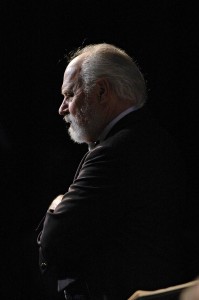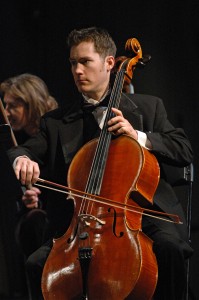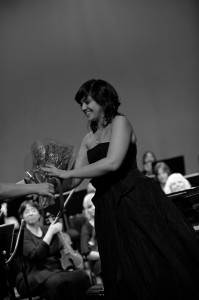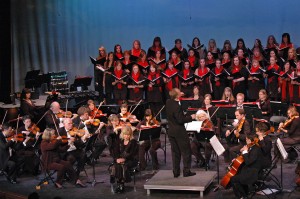I ran into one of the Symphony Board Members a couple of days ago and she reminded me that this was the 40th anniversary of the Symphony. So I felt it was worth reminding people that $20,000 symphony concerts don’t “just happen” and that there is a lot that goes into a concert. Here is a reprint of an article that I sent to the Townsman some years ago. Nothing much has changed; each concert is still a masterpiece of music and organization.
IT’S SYMPHONY SEASON AND IT’S A JUGGLING ACT: Symphony of Kootenays 2010/2011 Season. Article published in The Townsman, Wednesday October 13, 2010, page 23
It would seem to be simple enough. A bunch of musicians figure they have a potential audience and decide to give a public performance. They practice and rehearse; rent a venue; put up the posters; sell the tickets; play the gig and maybe walk away with some change in their pockets. For a rock quartet it is almost that simple but for a symphony orchestra there is nothing simple about the whole venture.
 Some of the problem is simply a product of scale. There are more musicians and more complex music. This in turn creates problems with financing and logistics. The Symphony of the Kootenays has been around for over 35 years and each year it is a juggling act of obtaining grants, sponsors and pull together the actual logistics of staging a concert. The organization’s annual budget is around $150,000 and each concert costs around $20,000 to $30,000. Naturally ticket sales only cover a fraction of the costs.
Some of the problem is simply a product of scale. There are more musicians and more complex music. This in turn creates problems with financing and logistics. The Symphony of the Kootenays has been around for over 35 years and each year it is a juggling act of obtaining grants, sponsors and pull together the actual logistics of staging a concert. The organization’s annual budget is around $150,000 and each concert costs around $20,000 to $30,000. Naturally ticket sales only cover a fraction of the costs.
As with most not-for-profit organizations the grant process has become more challenging. The monies available to not-for-profits have shrunk and there is fierce competition for what remains. Most available grants have strings attached. There are demands for Canadian content and prerequisites for adventurous programming. The granting organizations want to see the “best bang for their buck”. They feel it is important to have significant Canadian content and to promote adventurous programming. Compliance with these prerequisites, because of copy right issues, further increase costs.
Local corporate sponsors have been most generous over the years but often the decision to support local arts programs is out of local control. The final decisions are made at corporate headquarters and these may be located half a continent away. Despite this the symphony has managed to attract significant corporate sponsors and these have made the idea of a symphony season feasible and possible.
 The whole process of a concert season starts with the musical director and conductor Bruce Dunn and his selection of music for the up coming season. Bruce has to balance his duties as musical director of both the Kamloops Symphony, The Symphony of the Kootenays and his teaching activities across the province. He must strike a balance between the conditions of the grant applications, the skill set and availability of musicians (including soloists), the relatively small amount of rehearsal time available and the costs of the music. The latter is no small amount. The music has to be rented, distributed to the musicians and returned to the publishing house at the end of the concerts. Late compliance with the conditions of the rental can involve financial penalties. If the work is recent there are additional copyright costs as well. Printed music is not cheap. For example, the Arvo Part choral music for the Christmas concert last year cost an additional $1,500.
The whole process of a concert season starts with the musical director and conductor Bruce Dunn and his selection of music for the up coming season. Bruce has to balance his duties as musical director of both the Kamloops Symphony, The Symphony of the Kootenays and his teaching activities across the province. He must strike a balance between the conditions of the grant applications, the skill set and availability of musicians (including soloists), the relatively small amount of rehearsal time available and the costs of the music. The latter is no small amount. The music has to be rented, distributed to the musicians and returned to the publishing house at the end of the concerts. Late compliance with the conditions of the rental can involve financial penalties. If the work is recent there are additional copyright costs as well. Printed music is not cheap. For example, the Arvo Part choral music for the Christmas concert last year cost an additional $1,500.
Once the season’s concert programs have been selected then the logistics kick in. The composition of a Symphony Orchestra is not set in concrete. The size and variety of the orchestra is dictated by the music chosen. An orchestra to perform the early music of Haydn is significantly smaller than, say, the music of more modern composers. The equation is simple, the more musicians required then the greater the expense. More modern or adventurous music invariably requires more musicians and more expensive music.
For each concert the musicians have to be selected, contracts agreed upon, fees organized, and travel expenses negotiated. The musicians are all professionals and as professionals they need to be paid at a rate that is consistent with the going rate. Musicians for the concert come from far a field and there is fairly stiff competition for their services. Financially the local symphony is at a disadvantage when competing with larger population centres in Alberta. The musicians’ contracts are generally a five service agreement, three rehearsals and two concerts, spread over a three day week end. Once in town the musician have to be billeted. The cost of hotels for all the musicians would be too onerous for the organization to bear. If there is also a concert is out of town then transport of the musicians and instruments also has to be arranged. So apart from the organization, funding, music and logistics there is an army of volunteers to take care of the musicians while they are here.
That’s a lot of balls to keep in the air. And, of course, inevitably the question arises, why bother? Classical music is definitely not at the top of most local resident’s agenda. Then again why bother with an Arts Council, a Railway Museum, local theatre and the Key City or for that matter a Hockey team. At the best of times, apart from perhaps the Hockey team, local support for these activities is probably at fairly low ebb. Most of us do not spend a lot of time at any of these events, functions or facilities but they are all part of a “value added” profile for the City of Cranbrook. It attracts new residents, business and builds the profile of the city as a business, cultural and educational hub. For all residents this can only be a plus.
So here we are in October at the beginning of the Symphony season. All the balls are in the air and the first concert is scheduled for Saturday, October 23rd, 2010 at the Key City Theatre. This gala concert will feature a program of music by one of the big “Bs” of classical music (Bach, Beethoven & Brahms). Of the three the music of Ludwig Van Beethoven is probably the better known. The piano concerto #5 (The Emperor) will feature guest soloist Sarah Aleem. Currently Sarah lives and studies in Montreal but is returning to her home town for this concert. Also on the program will be Beethoven’s Prometheus Overture and his Symphony #6 (The Pastoral)
The annual Christmas concert will held December 3rd & 4th and will feature music of a Christmas fair by Purcell and Handel, including the Messiah. Other concerts are scheduled for February and April. In total there will be 5 concerts in the season.
– Rod Wilson
The following image was published in the Townsman following the early concerts of the 2010 / 2011 season.
Published in the Townsman, October 29, 2010, page 23: “A Triumphant Home Coming”. – Rod Wilson
– Rod Wilson

